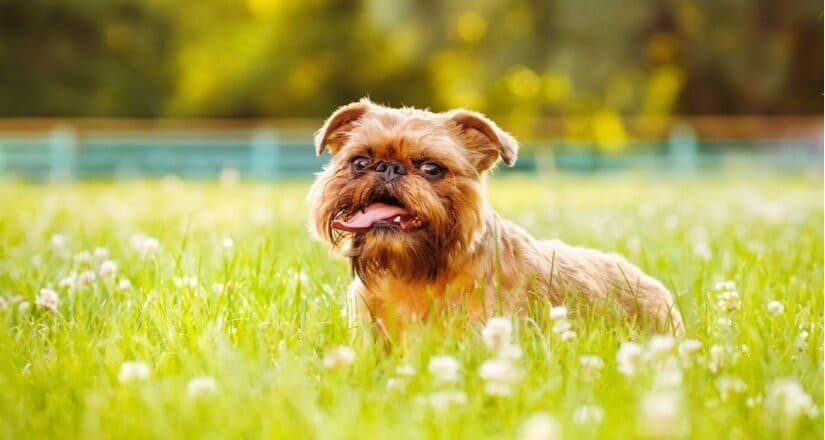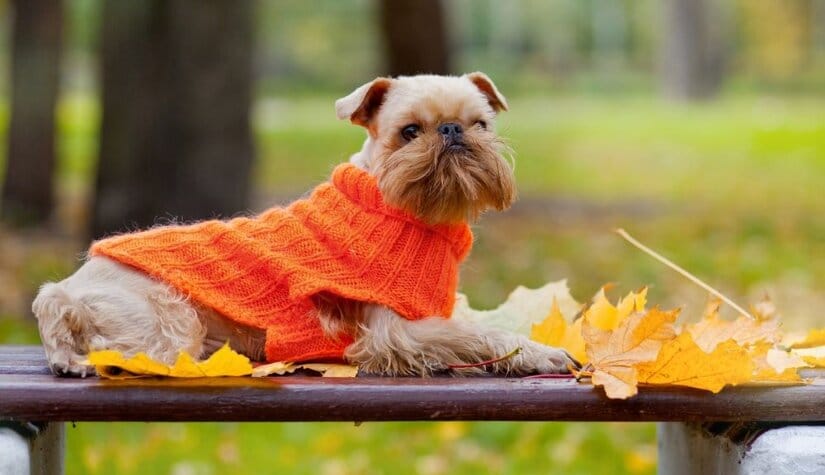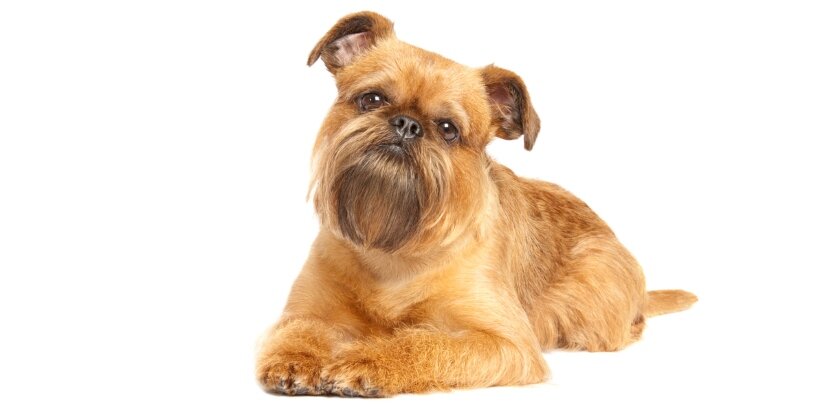



Toy Group
The Brussels Griffon is part of the UKC, Companion Group and the AKC, Toy Group. This dog breed originated in Brussels, Belgium. This dog breed was used to catch rats.
Brief History
The Brussels Griffon was bred to its existing form during the 19th century. The Belgium coachmen called this breed the “griffons d’ecurie” or “wire-coated stable dogs.” This breed was bred with Affenpinschers, Pugs, and English Toy Spaniels. There is also belief that the Brabancon, an old Belgium breed was mixed in, with possibly the Yorkshire Terrier breed.
When the Toy Spaniels were mixed in to the bloodline, this altered the facial characteristics of the Griffon. It was no longer good for rat catching. The Griff was registered with the AKC in 1910. After both world wars the Griff nearly became extinct. Once again, Griff admirers salvaged the breed in the U.S and the U.K.
Physical Description

The Brussels Griffon is a toy breed that has a short body. The body is thick, and the skull is large and round. The chin is undershot. With ears that are large and black, the Griff has a black, turned-up nose that is short and set back between both eyes. The ears are semi-erect, and can be cropped. The tail is docked. The Griff’s coat can be either smooth or rough. With a wiry, rough coat, the hair covers the head, and forms a fringe. The coat color can be either reddish brown, or black and reddish brown markings, or just plain black.
Temperament
The Griff is an intelligent dog breed, that is quirky and alert. This is a terrier dog breed meaning that it is quick to escape. This is a superb dog breed that has so many unique attributes. That said, the Griff is affectionate, loyal, and confident. The Griff may be hard to train. Some Griffs do not enjoy being around young children. Socialization and positive dog training should begin during puppyhood.
Special Needs
The Griff is prone to escaping, and should be kept within close proximity when out and about. Avoid over feeding this cute dog breed to prevent obesity. It’s hard to resist the affectionate Griff begging at the dinner table, but be sure to feed only healthy foods.
The Griff needs plenty of socialization, and positive training from puppyhood. This dog breed does best with daily exercise combined with mental stimulation. The Griff loves taking part in canine sporting activity even though it is a small dog breed. This bred does well with apartment living, and farm living. Daily grooming maintenance and care for this dog breed is necessary. Always consult with your veterinarian prior to flying with your Griff. This dog breed should only fly cabin.
The Griff is a brachycephalic breed, also known as a short-faced or snub-nosed dog breed, and should not fly using commercial plane travel. It is now recommended that the Griff fly by charter plane service like Pet Jets that have humans supervising pets at all times. The Griff enjoys trips to restaurants and Starbucks for Puppuchino’s and treats!
Possible Health Concerns

The Griff is an active and healthy dog breed that may be susceptible to the following health conditions:
- Brachycephalic Syndrome: Dogs with this problem will snore, snort and breathe through their mouths. The Griff tends to overheat easily, and tire quickly after exercise. Veterinarians may recommend surgery to enlarge the nasal openings.
- Cleft Palate: Griffs may be predisposed to this. This is caused by a defect in the formation of the jaw and face. It happens during embryonic development, resulting in a gap or cleft in the middle of the lip, mouth roof, or both. This will result in an open space through the mouth roof and into the Griff’s breathing passages. Consult with your veterinarian for advice.
- Laxating Patellas: This is a condition where the kneecap moves out of place. It is a common condition in smaller dog breeds.
- Hip Dysplasia: is an abnormal development of the hip joint in small dog breeds like the Griff. It is generally characterized by a loose joint, and then degenerative joint disease. Dogs should be fed a high-quality diet that is geared towards their life stage. Puppies should only be fed high-quality puppy dog food. Excessive growth, types of exercise, nutritional factors, and hereditary factors all come in to play with hip dysplasia. Consult with your veterinarian for expert advice.
- Heat Sensitivity: The Griff is heat sensitive. Heat stroke in dogs is when collapse is brought on by prolonged periods of heat stress or heat exhaustion. Symptoms will include cessation of sweating, panting, high body temperature, and even unconsciousness. Consult with your veterinarian for advice.
Exercise
The Griff does well with light exercise. A short walk around the block or brief trip to the dog park will suffice. Griffs enjoy dog training classes, obedience, agility and some rally sports. This should never be undertaken during hot or humid temperatures. Griffs need to be protected from extreme temperatures, and during the hot summer months’ indoor exercise is recommended. This dog breed does well with canine sports like tracking and agility. The Griff has to start with positive dog training during puppyhood, since this breed can become feisty with other dogs. This breed is an intelligent, friendly, and active dog breed that is very loyal. That said, give the Griff as many outdoor activities to enjoy.
Additionally, the Griff needs to be indoors during the hot summer months, and should only exercise during the early morning or evening hours, so as to keep cool and comfortable. All Griffs need to be protected from excessive during the summers.
Nutrition

This breed does well on a high- quality dog food. If you’re opting for home prepared dog food, consult with your veterinarian first. All dog food diets should have the approval of a veterinarian, and should be appropriate to the Griff. (age puppy, adult or senior). Some dog breeds pick up weight easily, and are prone to being overweight. That said, the Griff needs to eat a well-balanced dog food formula. Home-cooked meals work well for this dog breed.
The best dog foods are made with the simplest and most nutritious ingredients. Look for high-quality ingredients such as whole meats, fruits, vegetables, and grains, and take heed of the different macronutrients like proteins, fats, and carbs. Providing your dog with the most appropriate diet that is healthy and beneficial to his life stage, will help give your pet a long and healthy life.
As a Griff pet parent, you should look out for high-quality dog foods that are made by reputable companies with long histories of producing quality diets. Diets that have an Association of American Feed Control Officials (AAFCO) statement on the label saying that the diets have undergone animal feeding trials for the appropriate life stage are generally preferable to diets that are formulated by computer to meet AAFCO nutrient profiles for that life stage.
AAFCO model regulations and the federal feed laws stipulate that all pet food labels need to list all the ingredients in their formulas in descending order, according to the weight of each ingredient listed. With that said, it’s easy to see where the most important sources of calories and proteins are coming from – the first five ingredients listed.
The first ingredient is the one ingredient that is present in the highest amount. Always check the ingredients list, and use “Google” for dog food recalls to make sure that what you’re feeding is not being recalled. Tips on how to feed a healthy dog food diet to your Griff:
- Feed a diet from a well-known, reputable company. Contact them with any questions of concern.
- The labels on any diet should meet the levels established by the AAFCO Control Officials or feeding trials.
- All dog food formulas should have the following statement “Animal Feeding tests using the AAFCO procedures substantiate that “Brand X” provides completed and balanced nutrition for growth (or maintenance.)
- Feed puppy’s puppy food, and be sure to feed a small Toy puppy like the Griff a small Toy breed puppy formula.
Always consult with your veterinarian as to the best high-quality diet for your Griff.
Grooming
The Griff is easy to groom. The rough-coated Griffon does not shed. Daily brushing with a grooming glove or brush is recommended for both the smooth coated and rough coated Griff. Many Griffs will have their coats clipped for easy maintenance of this dog breed. The smooth coated Griff’s coat does shed during certain times of the year. Weekly bathing is required with an appropriate canine shampoo, alongside an ear cleaning and nail trimming every few weeks. That said, daily dental brushing with the use of chew toys, and dental treats help prevent plaque.
Adopting a Griff

This very small dog breed does well with attentive dog parents. The Griff enjoys travel, and being around people. Potential pet parents to this dog breed should be active, and enjoy taking the Griff with them for outings. These inquisitive and friendly dogs are so easygoing. By providing positive puppy training classes and early socialization skills, you can teach your Griff to get along with dogs, other people, and other animals. The Griff makes for a wonderful addition to equestrian farms, and cattle farms. They are also great for city living.
As with any dog adoption, make sure that you have the time and resources to take good care of your Griff. This is such a wonderful breed to adopt, but will need plenty of one-on-one time.
